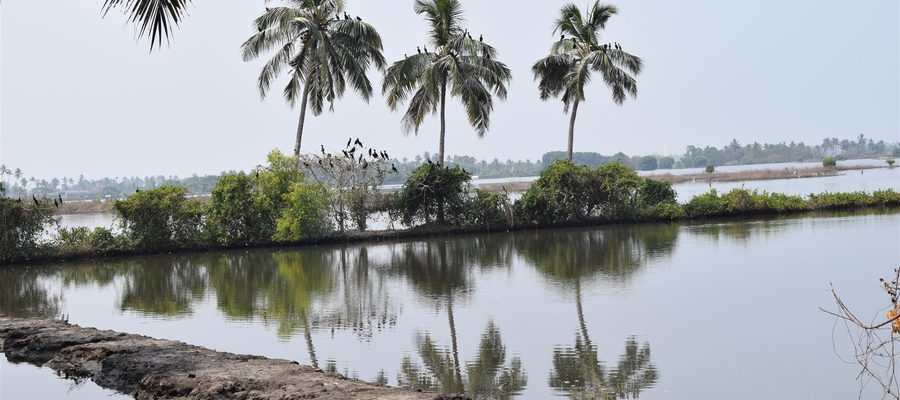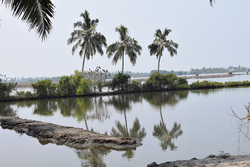BLOG: Lessons in Sustainability from India’s Past- Changing the Nature of Agricultural Practices

By Rithika Fernandes
The agricultural sector in India occupies a place of significance in its economy contributing 15 percent to the country’s GDP and employing 47 percent of its labour. It is also extremely sensitive to climate change with estimates of a loss of 1.5 percent of India’s GDP. While the impact of climate change on this sector is palpable, affecting food security around the world, agriculture has also contributed to GHG emissions in the practices employed through indiscriminate land clearing, consumption of fossil fuels in mechanised equipment, rice production and the raising of livestock. As more and more land lies fallow due to overuse of chemical fertilizers, natural farming has been gaining ground nudging farmers to re-embrace tried and tested techniques of the past which are forgotten in the present.
In city and peri-urban spaces, piles of leaves, kitchen scraps and other organic materials do not receive the respect they deserve. Perceived as waste, these resources which decompose into mulch and compost, are dumped in landfills, or burned, adding to the cocktail of emissions already present in the atmosphere. In the home-gardens of Sri Lanka and Southern India, however, organic material is held in high regard – commonly referred to as black gold. Home owners/farmers in these regions encourage the growth of a diverse array of vegetation from sandal, teak, coconut, rubber to flowering plants, pepper vines, paddy and vegetables. For them, rather than focussing on one crop and one harvest, using single irrigation on an area of land cultivating various types of produce is better. Mulch from the trees fertilise the plants below, providing shade as well. Mulching is a well known technique of water conservation enabling better resource use in areas which are water stressed. Furthermore, adding to the mix plants such as crown flower and neem, ensures a degree of pest control. In coastal areas, agro-ecosystems which comprise of a mix of trees and shrubs are grown as vegetative barriers protecting against wind and sand movement. Species are selected based on a number of parameters such as their popularity, stress tolerance, ability to be used as fuel and/or fodder etc. The home-gardens of Sri Lanka, in fact, are dynamic sustainable food production systems, which have continued to evolve across generations within the landscape to suit the local socio-economic, cultural and ecological needs. Recent research has also found that through increased landscape heterogeneity these types of ecosystems support large volumes of biodiversity.
In the southwest coast of one of the southern most states of India lies the Kuttanad region – an area which is spread across the districts of Alappuzha and Ernakulam of Kerala. A large part of the region is 0.6 to 2m below sea level, having been reclaimed from the Vembanad Lake. Here, Pokkali, a dying traditional practice of cultivating salt-tolerant rice varieties is being sown. Marshy tidal swamps formed as a result of flooding and tidal intrusions provide an excellent substrate for the special varieties of rice which Pokkali sows. The soil here is highly acidic and generally unfriendly to most varieties of paddy but the method employed of allowing for a mix of salt and rainwater has over the years allowed for the cultivation of Pokkali rice. The secret is in alternating the production of paddy with that of prawns. In Goa and Maharashtra, which have their own brand of Pokkali fields called Khazan lands and Khar respectively, a number of fish species are rotated with the paddy. Farmers only harvest one crop of rice in a year with prawn farming dominating the rest of the season. The paddy is grown during the low saline conditions (i.e. when the monsoons arrive) and the prawns are cultured during the high saline period. This practice is ecologically sound, an excellent example of natural farming. The fields act as reservoirs for the excess water during heavy rains while also providing a safe source of food and livelihood which operates in sync with natural cycles. ICLEI South Asia’s INTERACT-Bio project is investigating how effective these areas are in promoting biodiversity conservation as well as securing livelihoods within the cities of Kochi and Panaji.
With the increase in frequency of high intensity rainfall in many parts of India, flooding is often the biggest cause of infrastructural and economic damage. Areas which are highly flood prone are required to conduct regular de-silting of water bodies. Farmers in many parts of the country would use this silt in their fields to improve water absorption, water retention and soil fertility. With the increasing pollution of water bodies it is important that this be conducted with caution.
Many farmers have recognised the significance of green water (soil moisture used by plants) in agriculture leading to less instances of over irrigation of crops and more efficient water use. Techniques like mulching and raised bed farming allow for moisture retention. Crop rotation with legumes improves the nitrogen content of the soil while some species such as black gram can be grown in the moisture leftover after paddy has been harvested. Crop rotation also reduces soil erosion, acts as a disease and weed break and brings biological diversity back into the soil. In Nagaland, a local water conservation strategy called Zabo or Ruza combines techniques of water conservation with forestry, agriculture and animal care. Rainwater from forested hilltops collects into channels that lead to pond-like structures created on the terraced hillsides. The channels also pass through cattle yards, collecting the dung and urine of animals, before ultimately snaking their way into paddy fields at the foot of the hill. Ponds created in the paddy field are then used to rear fish and grow medicinal plants.
Another water optimising practice common in the North East (Khasi and Jaintia hills) is the Bamboo Drip Irrigation System. The system, made up of set of variously sized and diameter bamboo pipes, diverts water from perennial springs to the terrace fields. The roots of the cultivars (black pepper) receive small drops of water directly which meet their daily requirement in small volumes.
A perennial feature of the landscape India is the Cow. Revered in Hindu Mythology, Cows have meandered into urban areas as cityscapes cross over into rural areas. Cow dung, an all-purpose remedy, was used as a fuel or in biogas, an insect repellent, fertilizer and disinfectant. Although these greenish brown pats are gaining popularity among organic farmers who use it in pest control and as a fertiliser, in most cities it is discarded at garbage collection centres, fallen from grace like other organic counterparts.
Sheep penning, a practice of allowing sheep to graze in harvested fields, thereby collecting their dung within the field, was and still is common in many parts of south-western India. Another technique of ploughing crop residue back into the field recycles nutrients and helps to conserve moisture (by increasing water infiltration, cooling the soil surface and preventing erosion of the top soil).
The dynamics of food production is rapidly changing. Its association with areas outside cities is shifting to those within and around cities. Numerous studies are recognising the importance of developing agriculture within urban and peri-urban areas to improve food security. Roof-top gardens, vertical gardens, community gardens are actively being encouraged across the world. Developing urban and peri-urban agriculture results not only in heightened food security but also a certain degree of climate resilience, improved biodiversity and fosters a greater sense of community. Working on these issues through platforms such as ACCCRN, ESPA and IKI. ICLEI South Asia intends to build on and disseminate lessons learned, within and among city governments.
Documenting and mainstreaming traditional knowledge can really help boost the incorporation of nature based solutions within urban frameworks especially in the context of agriculture. Although the agricultural sector is a major source of GHG emissions, making the switch to these sustainable practices could really add up on a larger scale to enable not just a healthier planet, but healthier cities too.




